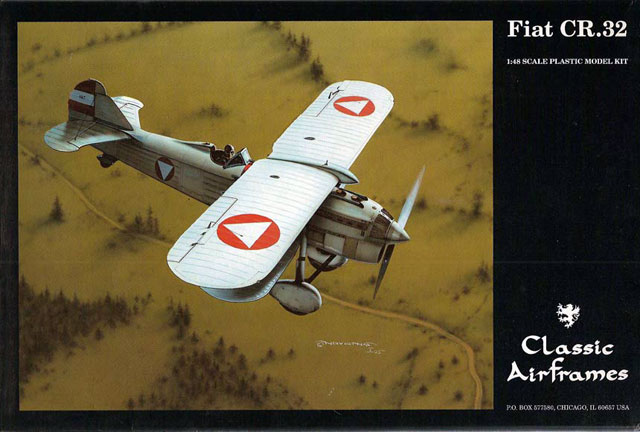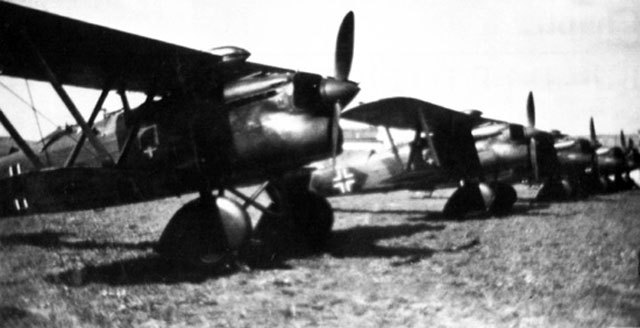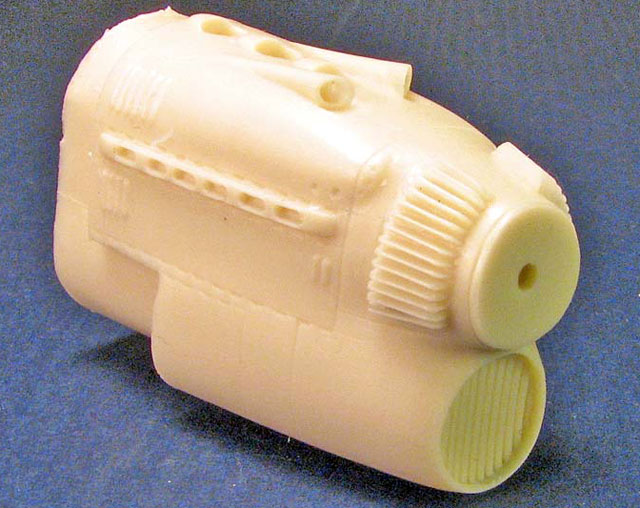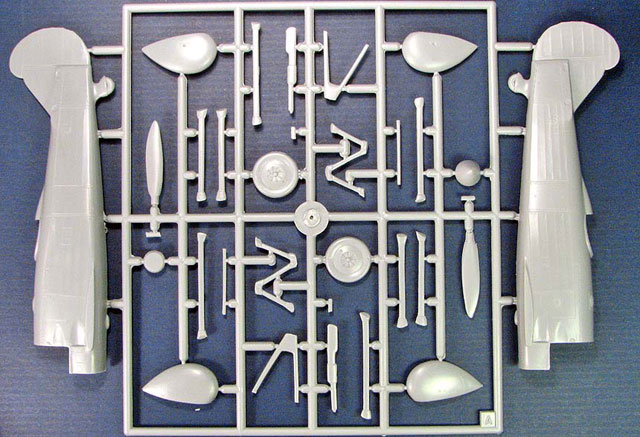|
Fiat CR.32
Foreign Service

Classic Airframes
S
u m m a r y
|
| Catalogue Number: |
4106 - Fiat CR.32 Foreign Service |
| Scale: |
1/48 |
| Contents and Media: |
33 parts in gray styrene, 22 parts in cream
colored resin, 12 pre-painted and 26 unpainted etched metal parts and 1
clear injection molded windshield. Instructions, decal sheet and
painting guide with markings for 5 aircraft. |
| Price: |
MSRP
USD$40.00
(available online for USD$35.96 from Squadron) |
| Review Type: |
FirstLook |
| Advantages: |
95% new tooling, painted etched metal. |
| Disadvantages: |
|
| Recommendation: |
Highly Recommended |
Reviewed by Steven "Modeldad" Eisenman

Classic
Airframes' 1/48 scale Fiat CR.32 will be available online from Squadron
The Fiat CR. 32 was introduced in April 1933 and
immediately became known for its superlative maneuverability. Not only
was it perceived as an excellent fighter, but it was also the star of
Italian aerobatic performances.
With its twin .303 Vickers or 0.50 cal Breda
machine guns and excellent handling it was one of the preeminent
fighters of the pre-war period, becoming known simply as the “Italian
Fighter”.
The CR in CR.32 stands for Caccia Rosatelli, or
Rosatelli’s Fighter. Celestino Rosatelli was Fiat’s chief designer.

In 1/48 kit form, this Classic Airframes issue is
the third offered to modelers. Although I have no direct knowledge, I
understand that a European vac kit was available many years ago. The
first kit was the SMER kit in approximately 1/50 scale. The second was
the Classic Airframes kit issued circa 1995. Now Classic Airframes has
once again brought out the CR.32, and it is a clear improvement on its
predecessors.
Having built two of the old SMER kits, spending
hours sanding down the kits 2x4 struts and scratch building many other
parts, I truly welcome this reissue. This is especially so, as I had
only one of the earlier CA offerings in my stash.
As I noted in the overview section above, this is
actually a partial new tooling, but what is new amounts to 95% of the
kit. All that was retained from the previous issue are the upper and
lower wings. All things considered, they still look pretty good with
very fine ribbed fabric surfaces.
The big news in this kit is the one-piece resin
forward fuselage and cowling. In the previous issue of this aircraft,
the forward part of the fuselage was a bit of a nondescript blob with
just the forward face, with the gills and intake, in resin.

The new forward end is a joy to behold. The gills
and intake are very finely done and the machine gun blast tubes are
beautifully represented, needing no drilling.
Test fitting appears to show that virtually no
filler will be needed when attaching the resin nose to the aft portion
of the fuselage. One point must be noted. The pour plug on the nose
flares out so it cannot be used as a fitment to the fuselage. You will
either need to cut it off and shave down the lower portion, or sand it
down so that it straight.
The fine engraving on the parts in the rest of the
kit are also a marked improvement over the previous issue. The wheels
and wheel covers are now molded as separate parts. The struts also are
more finely molded.

Click
the thumbnails below to view larger images:
Another benefit of this new issue is the tail
planes and rudder. They are all molded in fine resin. The elevators are
cast as separate pieces.
Although they were rarely used in practice, the kit
includes the lower wing-top machine gun coverings and barrels for the
bis model. In practice, these were found to erode the performance of
the nimble CR. 32.
Taking out the Ali D’Italia monograph on the CR.32,
and setting the new pieces on the 1/48 drawing, the pieces seem to match
nearly exactly. At this time, I’ve not heard that the Ali D’Italia
drawings are inaccurate.
Markings:
The decals are printed
by Microscale and are well printed and in register.

Click
the thumbnails below to view larger images:
-
Austrian Air Force 1938 – Silver doped
fabric, natural metal aluminum panels, and black struts. I believe
that this aircraft had the lower wing-top machine guns.
-
Luftwaffe Fighter
Trainer (Ex Austrian) – Silver doped fabric, natural aluminum
panels, and black struts. The swastika is in the white circle on
the red fin band. If you wanted, you could paint your CR.32 in a
Luftwaffe camouflage scheme of ….? You make the decision. In the
picture, is the first aircraft 70/71 or just a single green? Is the
Second aircraft in 61/62/63/65? I believe these aircraft are from
II Gruppen / JG 54
-
Royal Hungarian Air
Force 1940-1941, 2 /3 “Wespe” Squadron – The aircraft was repainted
in Hungary in a Medium Gray, Medium Brown and Dark Green topside
camouflage with a Light Blue-Gray underside. The aircraft carries
the chevron national marking of the early war period. There are
decals for the colorful Wasp emblem.
-
Royal Hungarian Air
Force 1943, Pilot Training School (aircraft formerly of 1 / 3 “Puma”
Squadron – The aircraft was repainted in Hungary in a Medium Gray,
Medium Brown and Dark Green topside camouflage with a Light
Blue-Gray underside. There is a yellow fuselage band and lower
under-wingtips. This aircraft carries the cross style national
markings as well as the red, white and green striped empennage.
-
Chinese Air Force, Shanghai, 1943 – The
instructions call for overall Olive Green. However, I don’t believe
that the exact colors are known. It could have been a random Dark
Green or even the Italian Verde Mimetico 3.
With all due acknowledgement of my personal
prejudice, I am quite glad to see a model of the CR.32 back in
production. This new issue looks particularly nice. This may be an
even better kit than the CR. 42 for a novice bi-plane builder. The
cockpit, in resin, appears far less fiddly than the intricate metal cage
of Classic Airframes CR. 42. But like the CR>42, inter-plane rigging is
minimal.
Highly Recommended.
References:
-
The Fiat CR.32,
Profile Publications Number 22, Profile Publications Ltd.,
Berkshire, England.
-
Fiat CR 32, Ali D’Italia, La Bancarella
Aeronautica, Torino 1996.
Thanks to
Classic Airframes for
the review sample.
Classic Airframes
kits are available worldwide through hobby retailers and from
Squadron.com
Review and Images Copyright © 2005 by
Steven "Modeldad" Eisenman
Page Created 07 December, 2005
Last updated 30 March, 2006
Back to HyperScale Main Page
Back to Reviews Page
|
Home | What's
New | Features
| Gallery |
Reviews | Reference
| Forum
| Search